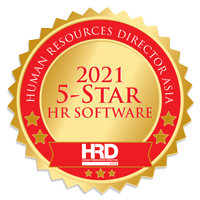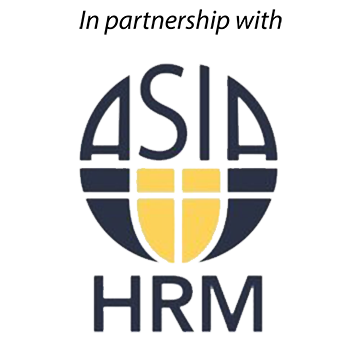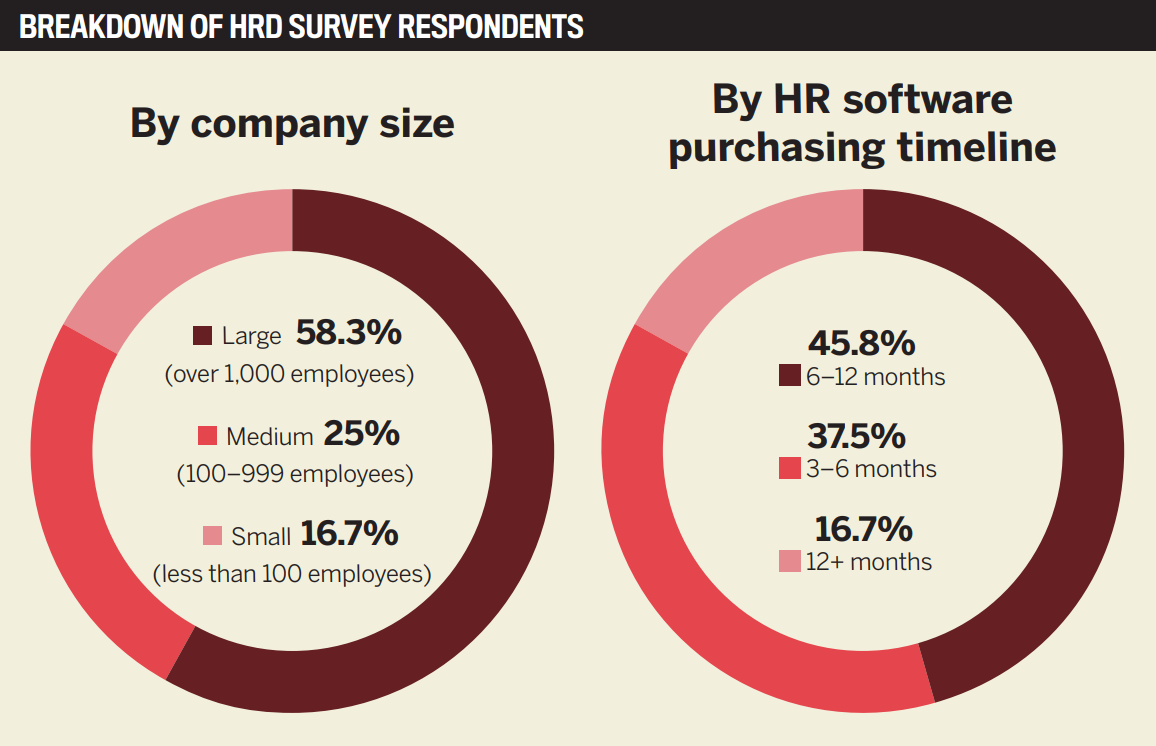

Jump to winners | Jump to methodology | View PDF

Predictability was a pre-2020 phenomenon. Since the onset of COVID-19, the new reality has consisted of flux, tumult and uncertainty. However, this period of unprecedented change isn’t just presenting new challenges, it’s also leading to some pretty smart solutions. In no sector is this more relevant than in HR software.
As Rita Tsui, founder of HR news and business intelligence portal AsiaHRM, told HRD Asia: “The HR tech and software industry has been evolving steadily over the past decade. But the speed of change accelerated with the pandemic – to the extent that the future of work is now.”
The 20 winners of HRD Asia’s 5-star HR Software Awards represent this precocious leap into the future, delivering solutions in HRIS, reward and recognition, payroll and recruitment. Their tools and platforms excel across all our survey criteria: speed, great user experience, value for money, seamless integration, customer support, and good compliance, functionality and features.
The pandemic has forced organisations to rethink how and where employees carry out their jobs, making more urgent the need for innovation to help figure out this new way of working. Luckily, investment in the HR technology sector is buoyant, tracking upwards even throughout the pandemic, says Tsui.
Notable examples are the USD153m investment in the upskilling platform startup DegreeD, the EUR122m funding for internal communications platform Staffbase and the USD300m investment in workforce management platform Workrise.
Tsui says that funding and acquisitions in the HR tech space point to organisations’ focus on two areas: software to address current problem areas and tech that prepares for the future of work.
The former includes enhanced employee attendance management systems, productivity tools, ongoing listening solutions, employee engagement tools, health and well-being platforms, upskilling platforms, and HR analytics tools.
The latter consists of employee experience platforms, performance management frameworks and tools, employee self-service models delivered through existing systems; adoption of AI and machine learning (ML) to solve HR problems, and people analytics tools.
Tsui says that funding and acquisitions in the HR tech space point to organisations’ focus on two areas: HR software to address current problem areas and tech that prepares for the future of work. The former includes enhanced employee attendance management systems, productivity tools, ongoing listening solutions, employee engagement tools, health and wellbeing platforms, upskilling platforms and HR analytics tools. The latter covers employee experience platforms, performance management frameworks and tools, employee self-service models delivered through existing systems, adoption of AI and machine learning (ML) to solve HR problems, and people analytics tools.

Integration leading to enterprise
As the HR software space continues to grow, HRD’s research has shown certain patterns in demand and usage for technology.
“With the rise of remote working, organisations across Asia are not only prioritising technologies – such as recognition software – that connect people. They demand ease of use to create a seamless employee experience,” says Alan Heyward, Asia-Pacific managing director at O.C. Tanner, which offers Culture Cloud employee recognition software and service awards.
“As a result, there’s a growing focus on integrating recognition features and functionality into major HRIS players like Workday, SAP, Bamboo HR, and enterprise social platforms such as Workplace by Facebook, to ensure recognition is available in the natural flow of work.”
Particularly in Asia, there’s a demand for speed in implementation, but Heyward cautions this must be balanced with other needs.
“A key differentiator of a successful program implementation and launch is in the careful alignment of a program to the organisational culture. Organisations that fail to do so will find themselves degrading the employee experience.”
Tech-based flexibility
Rob Squires, Asia head of sales at Ceridian, sees rising demand for cloud-based technologies such as the company’s comprehensive human capital management (HCM) cloud platform Dayforce, something which chimed with HRD’s internal research. What’s more, global clientele who operate in Asia seek solutions to tackle recent regulatory changes, driving growth of the HCM market. Companies also want tools to keep track of contract employees for regulatory compliance and scheduling optimisation.
“Managers can use HCM technology to provide more flexibility. Self-service functionality allows employees to view their schedules on any mobile device, update their own availability and trade shifts when unavailable to attend. Rosters are updated in real time, further reducing the administrative load. This functionality mirrors how employees use technology in other aspects of their lives, where everything is at their fingertips and on-demand, and they expect the same from their workplace.”
Squires says that in recruitment, AI plays a particularly impactful role, helping to ensure decision-making is fair and equitable, reducing administrative burdens and speeding up the hiring processes.
“With AI and machine learning (ML), there is tremendous potential for predictive intelligence. In the same way our cars tell us where we need to go and our watches tell us how to improve our diet, predictive intelligence will guide our HR decisions and help us stay one step ahead.”
A shift in attitudes
Heyward believes that behind the slow uptake of software lies a misconception about what HR is and what HR does. Many organisations perceive HR as more of an administrative, rather than a strategic, function.
However, he also sees more progressive organisations realising the strategic cultural value of recognition.
“For these employers, software is merely the enabler, and they use recognition as an important lever with which to build leader capability, and influence important culture metrics (eg talent retention, attraction, employee engagement) and bottom-line results.”
Employee wellbeing
Research from HRD found that wellbeing is at the heart of organisational strategy in 2021. The pandemic prompted employers to act decisively to safeguard employee mental health, meaning HR leaders relied increasingly on software to help facilitate the process.
“There has been a growing demand for software that facilitates employee wellbeing and diversity, equity and inclusion (DE&I) initiatives,” says Heyward.
“Our research confirms that when recognition is integrated well, organisations are four times more likely to have highly engaged employees, and 44% less likely to have employees suffering from burnout.”
Squires sees a central role for technology in ensuring the fluid, hybrid workplace puts physical, mental and financial health first.
“This can be achieved by applying disruptive technology to create experiences that engage and empower both employees and employers to embrace a more intelligent mode of working, creating quantifiable value for companies.”
What lies ahead
A permanently dispersed workforce will expect a better-designed user experience, says Squires and, importantly, will pay attention to how these experiences are delivered.
“Mobile technology underpinned by predictive analysis is a key part of building a tailored and connected experience for a hybrid workforce and will continue to be an imperative in the future,” he reveals. Heyward sees the continued trend of more start-ups in Asia challenging the dominance of established market players.
“We’ve seen new technology with a lot of bells and whistles, and for some, really clever marketing. As the HR tech market in Asia matures, organisations will wise up to these tactics, and will select proven partners with a strong track record in delivering not only implementation and sustained innovation, but also alignment to their organisational needs and objectives.”
The HRD Asia 5-star HR Software Awards winners were selected according to a survey conducted by the magazine’s research and intelligence team over nine weeks, from March to May this year. The team sought the opinions of the HR professionals on its extensive database. Companies that scored a rating of 80% or higher on criteria across all four categories (HRIS, payroll, recruitment, reward and recognition) were declared winners. Survey participants were asked to name their software of choice for each category, and to rate them according to a range of criteria common to all categories, such as ease of use or ease of use for HR, customer support and value for money. Then, for each category, the criteria are the following:
HRIS: employee experience, ease of implementation, customisation, streamlining of processes, value for money and customer support
Payroll: level of automation, compliance features, customisation, seamless integration, time saving, value for money, customer support, functionality and features
Reward and recognition: employee experience, real-time analytics, peer-to-peer recognition, time saving, value for money, customer support, functionality and features
Recruitment: candidate experience, time saving, ease of integration and implementation, functionality and features